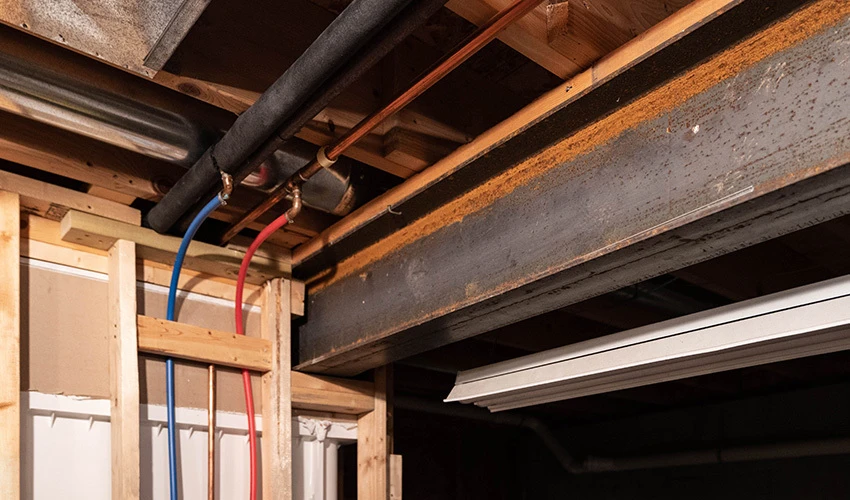How to Tell if a Wall is Load Bearing

Before taking on any home renovations that involve removing walls, whether you’re updating the design to create an open floor plan or adding more space, you need to understand whether a wall is cosmetic or load-bearing. Knowing how to tell if a wall is load-bearing is crucial to your home's safety and stability. Don’t attempt to remove any wall until you know how it functions in relation to the structural integrity of your home. If the wall you are considering removing is a load-bearing wall, you may want to change your renovation plans. Here’s why.
What Is a Load Bearing Wall?
Load bearing walls are responsible for supporting the weight of certain features of your home. They are holding up structural components like the roof of your home, and in some cases the floors above them. Sometimes called “bearing walls,” they are designed to transfer weight from the top of the house to the foundation.
Demolishing a load-bearing wall could quickly impact the safety of your home, as removing it threatens the structural integrity of your building. Making sure the wall you plan to remove isn’t load-bearing is incredibly critical.
How to Determine If a Wall Is Load-Bearing
Determining if a wall is load-bearing is crucial before making any structural changes. A few things can help you tell if a wall is load-bearing:
- Grab the blueprints — A great place to start is by digging out the original blueprints if they’re available. The original blueprints for the home will tell you which walls are load-bearing and which are not. If a wall is marked as “S” in the blueprint, this means “structural,” thus showing it’s a load-bearing wall.
- Check your ceiling — Take a look at your ceiling to identify any load-bearing beams that run across the house. Any walls beneath these beams are probably also load-bearing. If you can’t identify a load-bearing beam below the wall, it’s most likely not supporting any weight. However, it’s always best to confirm via the blueprints or get an expert's opinion.
- Assess your basement — Look in your basement or crawl space for steel beams or joists. If you spot joists in your basement and there is a wall that runs perpendicular, it's most likely a load-bearing wall. If the wall is parallel above the joists, it’s most likely not a load-bearing wall.
- Check the foundation — If a wall or beam is directly connected to the foundation of your house, it is a load-bearing wall. This is particularly true for homes with additions, since walls that are interior now may have originally been exterior walls. Checking your home’s original blueprint can help with this.

Load-Bearing Wall Removal: Know the Facts
Now that you know how to tell if a wall is load-bearing, you could remove a load-bearing wall. But you should never do it without consulting a professional builder or engineer. They will know how to tell if a wall is load-bearing or not.
If you remove a load-bearing wall without the proper planning, it could quickly lead to disaster in the form of structural instability, ceiling sagging, or worse, collapse.
How to determine a load-bearing wall is important, but there are other factors that also need to be considered. For example:
- A permit could be required — Some city ordinances require a permit and a structural engineer's sign-off if walls are being replaced or torn down.
- Replacement support is mandatory — Structural support must be in place before removing the wall. It’s necessary to have a plan in place; otherwise, your home will start to sag over time.
- Know your beams — For this type of project, a heavy-duty beam is needed if you are looking to fully remove a load-bearing wall. By purchasing and installing an LVL (laminated veneer lumber) support beam, you can ensure the stability of your home’s structure – you simply can’t rely on anything smaller to support your roof properly.
- Removal is dangerous — Removing load-bearing walls can be a difficult and dangerous task. When deciding to remove one, it is necessary to take the proper safety precautions at all times. Never complete this task on your own. Always call an expert who knows how to tell if a wall is load-bearing and how to remove it. This will help you avoid disaster.

Alternatives To Removing a Load-Bearing Wall
Sometimes, the cost and labor involved in removing a load-bearing wall are more than a homeowner planned for originally. At this point, exploring alternatives to removing a load-bearing wall may prove to be the best option.
Pass-thru openings allow homeowners to keep load-bearing walls intact while helping achieve the desired open floor plan functionality. It is also a less expensive option than removal, easier to install, and often doesn't require extra costs in the way of permits or engineers.
Trust the Experts at Mr. Handyman
If you are ready to renovate your home, the team of licensed contractors and expertly trained service professionals at your local Mr. Handyman® will ensure your project gets completed to your satisfaction and in accordance with all specifications.
Trust your local professionals at Mr. Handyman to help turn your dream renovation into a reality—even if it includes moving a load-bearing wall.
Schedule an appointment online to get started today.
This article is intended for general guidance only and is not applicable to every situation. You are responsible for determining the proper course of action for your property and situation. Mr. Handyman is not responsible for any damages that occur as a result of advice and/or guidance derived from its blog content.
Some Mr. Handyman services vary by location. Contact your local Mr. Handyman franchise for more information.
FAQs: Load Bearing Walls
For more than 25 years, Mr. Handyman has been the trusted choice for homeowners tackling repairs, upkeep, and upgrades. Whether it’s fixing what’s broken or improving what’s already there, we handle it all. We’re also here to clear up any confusion about home maintenance and renovations. Below, you’ll find answers to some of the most common questions about load-bearing walls.
Is there an easy way to tell if a wall is load-bearing?
The easiest way to tell if a wall is load-bearing is to check the blueprints for your home. Here, the plans will indicate an S for “structural” to indicate if a wall is load bearing. The safest way is to hire a professional to assess the wall in question.
What are the disadvantages of removing a load-bearing wall?
Removing a load-bearing wall could be extremely detrimental to your home. If not done correctly, you could cause significant structural damage. Before making any remodeling or renovation decisions, be sure to consult an expert who knows how to tell if a wall is load-bearing.
What are the advantages of removing a load-bearing wall?
Hiring a professional to remove load-bearing walls in order to open up the floor plan or redesign the layout of a home can completely change the look, feel, and functionality. Since many people desire an open floor plan, such a renovation can increase the value of a home.
Do you need a permit to tear down a load-bearing wall?
Yes. Because it can significantly alter the structural integrity of your home, in almost all cases, you will need a permit from your town or city to remove or relocate a load-bearing wall.
Should I hire a professional to remove a load-bearing wall?
Yes. Removing a load-bearing wall can be extremely complicated and dangerous. You should not attempt to do this on your own. Calling a professional who knows how to determine a load-bearing wall and the best way to remove it can save you considerable time, money, and provides peace of mind that the job was done based on plans drafted by a structural engineer and approved by your local building authority.
What does it cost to remove a load-bearing wall?
Depending on the size and scope of the project, and the amount of work involved the cost to remove a load-bearing wall can be considerable. Each project is different and should be discussed with a trusted and experienced service professional. Generally, costs can range between $1,200 and $3,000 for a single-story home and between $3,000 and $10,000 for a multi-story home.
 Click to call
Click to call


